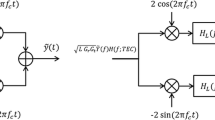Abstract
The residual error of the ionospheric correction of signals from dual frequency GPS systems, related to a ray deviation in random ionospheric irregularities, is studied. The formulas taking into account ray deviation from a straight line in an inhomogeneous ionosphere have been obtained based on the disturbance theory when solving the ray equations. These formulas have been used to estimate the extreme accuracy of a dual frequency GPS method. The algorithm for correcting this ionospheric error of the second order using three-frequency reception has been proposed.
Similar content being viewed by others
References
E. L. Afraimovich, V. V. Demyanov, and T. N. Kondakova, “Degradation of GPS Performance in Geomagnetically Disturbed Conditions,” GPS-Solutions 7(2), 109–119 (2003).
G. O. Ajayi, A. Hedberg, and G. Hamberg, “Accurate Determination of Ionospheric Effects on Satellite-Based Positoning Systems in Terms of Residual Error,” Radio Sci. 15(1), 1009–1016 (1980).
Ya. L. Alpert, Electromagnetic Wave Propagation and the Ionosphere (Nauka, Moscow, 1972) [in Russian].
C. Alber, R. Ware, C. Rocken, and F. Solheim, “GPS-Surveying with 1 mm Precision Using Corrections for Atmospheric Slant Path Delay,” Geophys. Res. Lett. 24(15), 1859–1862 (1997).
A. Belehaki, N. Jakowski, and B. W. Reinisch, Comparison of Ionospheric Ionization Measurements over Athens Using Ground Ionosonde and GPS-Derived TEC Values, Radio Sci. 38(6), 1105 (2003).
F. K. Brunner and M. Gu, “An Improved Model for the Dual Frequency Ionospheric Correction of GPS Observations,” Manuscr. Geod. 16(3), 205–214 (1991).
A. El-Rabbany, Introduction to GPS: The Global Positioning System (Artech House, 2002).
L. M. Erukhimov, O. I. Maksimenko, and E. N. Myasnikov, “On an Inhomogeneous Structure of the Topside Ionosphere,” Ionos. Issled., No. 30, 27–48 (1980).
U. Fernandez-Plazaola, T. M. Martin-Guerrero, J. T. Entrambasaguas-Munoz, and M. Martin-Neira, “The Null Method Applied to GNSS Three-Carrier Phase Ambiguity Resolution,” J. Geod. 78(1), 96–102 (2004).
B. N. Gershman, L. M. Erukhimov, and Yu. Ya. Yashin, Wave Phenomena in the Ionosphere and Cosmic Plasma (Nauka, Moscow, 1984) [in Russian].
V. E. Gherm, N. N. Zernov, S. M. Radicella, and H. J. Strangeways, “A Propagation Model for Signal Fluctuations on Transionospheric Radiolinks,” Radio Sci. 35(5), 1221–1232 (2000).
M. E. Gorbunov, “Ionospheric Correction and Statistical Optimization of Radio Occultation Data,” Radio Sci. 37(5), 1084 (2002).
M. Gu and F. K. Brunner, “Theory of the Two Frequency Dispersive Range Correction,” Manuscr. Geod. 15, 357–361 (1990).
R. Hatch, J. Jung, P. Enge, and B. Pervan, “Civilian GPS: The Benefits of Three Frequencies,” GPS-Solutions 3(4), 1–9 (2000).
S. Kedar, G. A. Hajj, B. D. Wilson, and M. B. Heflin, “The Effect of the Second Order GPS-Ionospheric Correction of Receiver Positions,” Geophys. Res. Lett. 30(16), 1829 (2003).
J. A. Klobuchar and J. M. Kunches, “Comparative Range Delay and Variability of the Earth’s Troposphere and Ionosphere,” GPS-Solutions 7(1), 55–58 (2003).
S. N. Kolesnik, M. V. Tinin, and N. T. Afanas’ev, “Imitation Modeling of Radio Propagation in a Randomly Inhomogeneous Ionosphere Taking into Account Ionospheric Sphericity,” Izv. Vyssh. Uchebn. Zaved, Radiofiz. 45(9), 731–746 (2002a).
S. N. Kolesnik, M. V. Tinin, and N. T. Afanasiev, “Statistical Characteristics of a Wave Propagating through a Layer with Random Irregularities,” Waves Random Media 12(4), 417–431 (2002b).
Yu. A. Kravtsov and Yu. I. Orlov, Geometrical Optics of Inhomogeneous Media (Nauka, Moscow, 1980) [in Russian].
Yu. A. Kravtsov, Z. I. Feizulin, and A. G. Vinogradov, Radio Propagation through the Earth’s Atmosphere (Radio Svyaz’, Moscow, 1983) [in Russian].
J. M. Kunches and J. A. Klobuchar “Eye on the Ionosphere: GPS after SA,” GPS-Solutions 4(3), 52–54 (2001).
M. Olynik, M. G. Petrovello, M. E. Cannjn, and G. Lachapelle, “Temporal Impact of Selected GPS-Errors on Point Positioning,” GPS-Solutions 6(1–2), 45–57 (2002).
R. E. Schaal and A. P. C. Larocca, “A Methodology for Monitoring Vertical Dynamic Sub-Centimeter Displacements with GPS,” GPS-Solutions 5(3), 15–18 (2002).
M. Sekido, T. Kondo, E. Kawai, and M. Imae, “Evaluation of GPS-Based Ionospheric TEC Map by Comparing with VLBI Data,” Radio Sci. 38(4), 1069 (2003).
H. J. Strangeways and R. T. Ioannides, “Rigorous Calculation of Ionospheric Effects on GPS=Earth-Satellite Paths Using a Precise Path Determination Method,” Acta Geod. Geophys. 37(2), 281–292 (2002).
S. Syndergaard, “A New Algorithm for Retrieving GPS Radio Occultation Total Electron Content,” Geophys. Res. Lett. 29(16), 1029 (2002).
V.I. Tatarskii, Radio Propagation in a Turbulent Atmosphere (Nauka, Moscow, 1967), [in Russian].
J. B.-Y. Tsui, Fundamentals of Global Positioning System Receivers: A Software Approach, 2nd Ed. (Wiley & Sons, New Jersey, 2005).
V. V. Vorob’ev and V. Kan, “Background Fluctuations during Radio Sounding of the Ionosphere in the GPS-Microlab-1 Experiment,” Izv. Vyssh. Uchebn. Zaved., Radiofiz., 42(6), 511–523 (1999).
K. C. Yeh and C. H. Liu, “Radio-Wave Scintillations in the Ionosphere,” Proc. IEEE 70(4), 324–360 (1982).
Author information
Authors and Affiliations
Additional information
Original Russian Text © B.-Ch. Kim, M.V. Tinin, 2007, published in Geomagnetizm i Aeronomiya, 2007, Vol. 47, No. 2, pp. 254–259.
Rights and permissions
About this article
Cite this article
Kim, B.C., Tinin, M.V. Effect of ionospheric irregularities on accuracy of dual-frequency GPS systems. Geomagn. Aeron. 47, 238–243 (2007). https://doi.org/10.1134/S0016793207020120
Received:
Accepted:
Issue Date:
DOI: https://doi.org/10.1134/S0016793207020120




